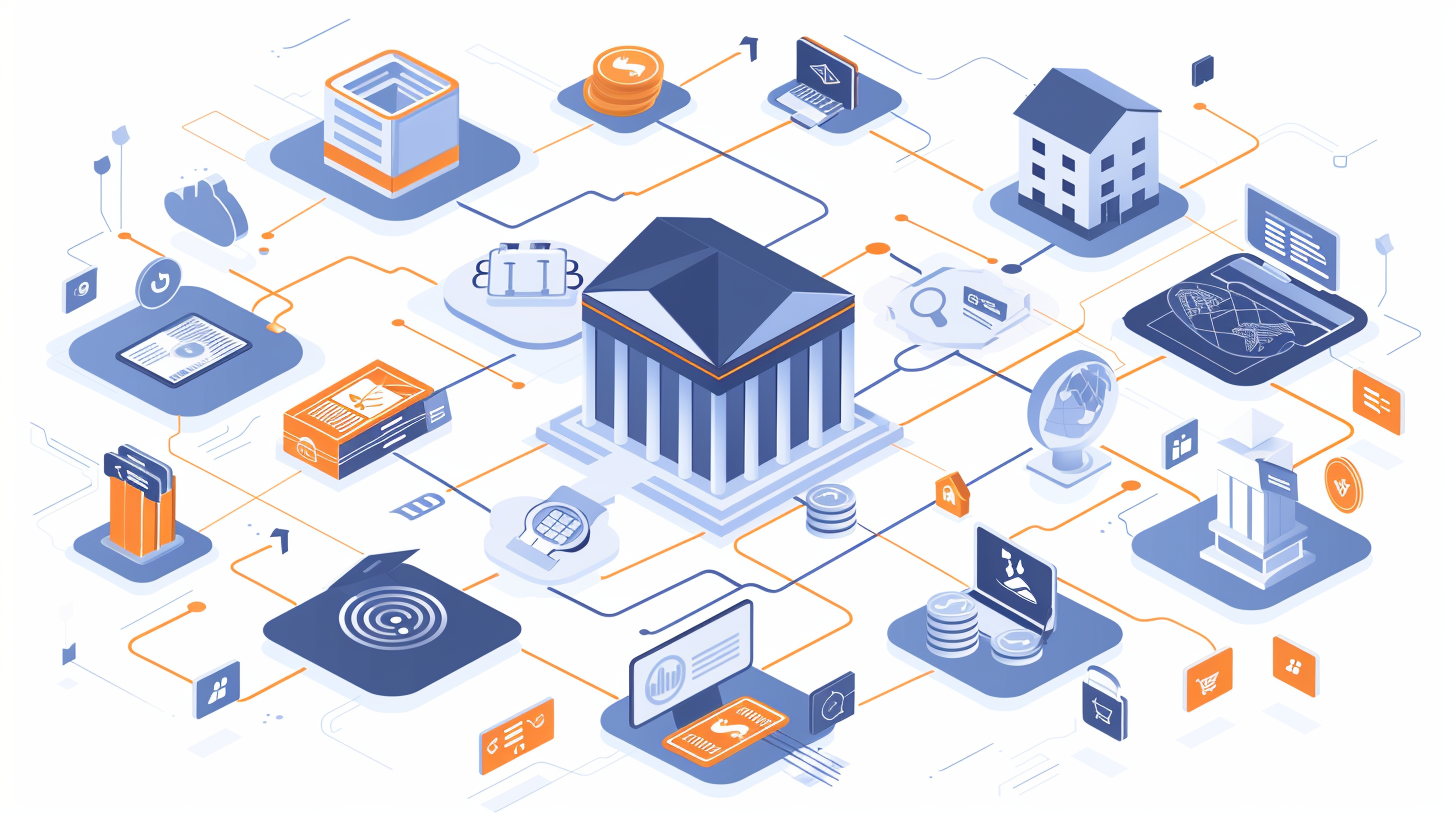The Digital Detective: How Data Analytics Is Revolutionizing Crime Fighting in Finance
 In the financial industry, where vast sums of money are moved across the globe at lightning speed, the specter of financial crime looms large. Financial institutions face relentless threats from money laundering, fraud, cyber-attacks, and other financial crimes that not only endanger their operations but also their reputation and the trust of their customers. In this high-stakes environment, data analytics emerges as a crucial ally in the battle against financial crime, offering powerful tools for detection, prevention, and compliance.
In the financial industry, where vast sums of money are moved across the globe at lightning speed, the specter of financial crime looms large. Financial institutions face relentless threats from money laundering, fraud, cyber-attacks, and other financial crimes that not only endanger their operations but also their reputation and the trust of their customers. In this high-stakes environment, data analytics emerges as a crucial ally in the battle against financial crime, offering powerful tools for detection, prevention, and compliance.
Understanding Financial Crime
The Evolution of Data Analytics in Finance
The advent of big data and advanced analytics technologies has transformed the financial landscape, enabling institutions to harness vast amounts of data for insights and decision-making. Data analytics in the context of financial crime prevention involves the systematic analysis of transactions, customer behavior, and other relevant data to identify patterns, trends, and anomalies indicative of illicit activity.
The narrative of data analytics in finance is a fascinating evolution from rudimentary bookkeeping to harnessing the power of cutting-edge technologies for crime detection and prevention. This journey underscores the finance sector’s adaptability and its relentless pursuit of integrity and security amidst the growing sophistication of financial crimes.
The Genesis: Bookkeeping and the First Strides towards Analytics
 In its infancy, data analytics in finance was synonymous with meticulous bookkeeping—a practice dating back centuries, aimed at ensuring accuracy in financial records. This era of descriptive analytics provided a foundational understanding of financial activities, albeit with a backward-looking focus.
In its infancy, data analytics in finance was synonymous with meticulous bookkeeping—a practice dating back centuries, aimed at ensuring accuracy in financial records. This era of descriptive analytics provided a foundational understanding of financial activities, albeit with a backward-looking focus.
Entering the Digital Era: The Role of Computers
The integration of computers into finance during the mid-20th century marked a pivotal shift. This period introduced electronic data processing, setting the stage for statistical models that could analyze financial data for trends and anomalies. Initially, these efforts were more aligned with market analysis than crime detection.
The Digital Revolution and the Dawn of Financial Crime Detection
The 1990s heralded a digital revolution, characterized by the explosion of online banking and electronic transactions. This surge in digital financial activity brought with it an increased risk of financial crime, prompting institutions to explore data analytics as a tool for detection. It was during this era that the finance sector began to employ analytics for spotting irregularities indicative of fraud or money laundering.
Detecting Financial Crime with Data Analytics
 Data analytics tools leverage machine learning algorithms and statistical methods to sift through millions of transactions in real-time, flagging those that deviate from established norms or match known patterns of financial crime. This proactive approach allows financial institutions to quickly identify potential threats and take corrective action before significant damage is done. For example, a sudden spike in high-value transactions in a low-activity account could trigger an alert for further investigation.
Data analytics tools leverage machine learning algorithms and statistical methods to sift through millions of transactions in real-time, flagging those that deviate from established norms or match known patterns of financial crime. This proactive approach allows financial institutions to quickly identify potential threats and take corrective action before significant damage is done. For example, a sudden spike in high-value transactions in a low-activity account could trigger an alert for further investigation.
A Notable Historical Example: The Detection of the Enron Scandal
A landmark moment in the history of financial crime detection through data analytics was the uncovering of the Enron scandal in the early 2000s. Analysts and investigators utilized sophisticated data analysis techniques to sift through Enron’s complex financial records, uncovering a web of fraudulent practices designed to hide the company’s financial instability. This case underscored the potential of data analytics not just for understanding financial transactions but for exposing deceit and malfeasance.
The Age of Predictive Analytics and Machine Learning
The advent of the 21st century marked the transition from merely detecting to predicting financial crimes. With the introduction of machine learning and big data technologies, financial institutions could now analyze extensive datasets in real-time, identifying patterns that precede criminal activities. These predictive models represented a paradigm shift, offering a glimpse into potential future crimes and enabling preemptive action.
Predictive analytics and machine learning have revolutionized the way financial institutions approach the prevention of financial crime. These technologies enable the analysis of patterns and trends from vast datasets, predicting future fraudulent activities with a high degree of accuracy.
Looking Forward: The Continued Evolution of Data Analytics
As we look to the future, the role of data analytics in detecting and preventing financial crime continues to evolve, driven by technological advancements and the ingenuity of financial professionals. The historical journey from simple bookkeeping to AI and blockchain illustrates a sector that is increasingly capable of not just reacting to financial crime but anticipating and nullifying it before it occurs. This progression is a testament to the finance industry’s commitment to safeguarding assets and maintaining trust in an ever-complex financial landscape
In recent years, artificial intelligence (AI) and blockchain technology have significantly bolstered the finance sector’s capabilities in fighting financial crime. AI’s learning algorithms have become adept at detecting complex and subtle patterns of illicit behavior, offering a level of precision and speed previously unattainable. Meanwhile, blockchain’s transparent and immutable record-keeping presents a formidable barrier to transactional fraud, enhancing the sector’s resilience against criminal exploits.
Preventing Financial Crime Through Predictive Analytics
 Beyond detection, data analytics plays a crucial role in preventing financial crime by predicting future risks and vulnerabilities. Predictive analytics models can forecast potential criminal behavior based on historical data and emerging trends, enabling institutions to strengthen their defenses in high-risk areas. By understanding where vulnerabilities may lie, financial institutions can implement targeted controls, such as enhanced due diligence for certain transactions or customers, thereby mitigating the risk of financial crime.
Beyond detection, data analytics plays a crucial role in preventing financial crime by predicting future risks and vulnerabilities. Predictive analytics models can forecast potential criminal behavior based on historical data and emerging trends, enabling institutions to strengthen their defenses in high-risk areas. By understanding where vulnerabilities may lie, financial institutions can implement targeted controls, such as enhanced due diligence for certain transactions or customers, thereby mitigating the risk of financial crime.
Compliance and Regulatory Reporting
Regulatory compliance is a significant aspect of financial crime prevention. Data analytics assists financial institutions in adhering to complex regulatory requirements by automating the monitoring and reporting processes. Advanced analytics can streamline the compilation of reports for regulatory bodies, ensuring accuracy and timeliness. This not only helps in meeting legal obligations but also in maintaining a robust compliance posture.
Data analytics enhances compliance and regulatory reporting beyond just following laws; it promotes transparency and integrity. Automated data analysis helps identify potential compliance breaches or illegal activities swiftly, enabling immediate operational adjustments to stay within legal limits and avoid fines or damage to reputation.
Data analytics integration into compliance efforts provides clear insights into risks and customer actions. By analyzing transaction data, financial institutions can detect patterns, evaluate transaction risks, and adjust compliance strategies effectively. Such insights improve decision-making and the effectiveness of compliance activities, including due diligence, transaction monitoring, and risk management, strengthening defenses against financial crime.
As regulations and financial crime methods evolve, data analytics offers essential flexibility, allowing financial institutions to quickly adapt to changes and new threats. With regulatory authorities moving towards tech-driven monitoring, institutions with advanced analytics can better predict regulatory shifts and refine their compliance to meet best practices, reducing financial crime risks and leading in compliance and integrity
Challenges and Considerations
While data analytics offers tremendous potential in the fight against financial crime, it also presents challenges. Privacy concerns, data quality, and the need for skilled analysts are among the key issues that institutions must navigate. Additionally, criminals continually adapt their strategies to evade detection, requiring constant refinement of analytics models.
The Future of Financial Crime Prevention
The future of financial crime prevention lies in the further integration of data analytics with emerging technologies such as artificial intelligence (AI) and blockchain. AI can enhance the capabilities of analytics tools by learning from new data and adapting to evolving criminal tactics. Blockchain technology, with its transparent and immutable ledger, holds promise for reducing fraud and improving the traceability of transactions.
Conclusion
The role of data analytics in detecting and preventing financial crime is increasingly indispensable in the digital age. By leveraging the power of data, financial institutions can stay one step ahead of criminals, safeguarding their operations and protecting the financial system at large. As technology advances, the synergy between analytics, AI, and blockchain will pave the way for even more effective strategies to combat financial crime.
 Mitigation strategies involve both physical and economic measures. Upgrading infrastructure to withstand seismic forces is a long-term but essential endeavor. Financial institutions and markets can also adopt more agile operational models, including disaster recovery sites and digital platforms that ensure continuity of services during disruptions.
Mitigation strategies involve both physical and economic measures. Upgrading infrastructure to withstand seismic forces is a long-term but essential endeavor. Financial institutions and markets can also adopt more agile operational models, including disaster recovery sites and digital platforms that ensure continuity of services during disruptions.
 The arrival of the COVID-19 pandemic in early 2020 tested the NJ/NY area’s economic resilience as never before. As businesses shuttered and the stock market experienced volatile swings, the pandemic highlighted the importance of economic flexibility and the ability to quickly adapt to changing circumstances. It also stressed the significance of digital transformation in maintaining business operations and the crucial role of healthcare infrastructure in public and economic health.
The arrival of the COVID-19 pandemic in early 2020 tested the NJ/NY area’s economic resilience as never before. As businesses shuttered and the stock market experienced volatile swings, the pandemic highlighted the importance of economic flexibility and the ability to quickly adapt to changing circumstances. It also stressed the significance of digital transformation in maintaining business operations and the crucial role of healthcare infrastructure in public and economic health. The September 11, 2001, terrorist attacks on the World Trade Center in New York City were a profound tragedy that reshaped the world in countless ways. Beyond the immediate loss of life and physical destruction, 9/11 led to a complete reevaluation of security protocols, emergency response strategies, and financial market protections against terrorism. The attacks also demonstrated the strength of community and the importance of national and international cooperation in the face of shared threats.
The September 11, 2001, terrorist attacks on the World Trade Center in New York City were a profound tragedy that reshaped the world in countless ways. Beyond the immediate loss of life and physical destruction, 9/11 led to a complete reevaluation of security protocols, emergency response strategies, and financial market protections against terrorism. The attacks also demonstrated the strength of community and the importance of national and international cooperation in the face of shared threats. The NJ/NY area’s history with disasters, both natural and human-made, illustrates the complex web of vulnerabilities that can impact the region. Each event, from Superstorm Sandy to the COVID-19 pandemic, provides critical lessons in preparedness, response, and recovery. By adopting a multi-hazard approach to disaster resilience, focusing on strengthening infrastructure, enhancing security measures, and fostering community and economic flexibility, the region can better navigate the challenges of tomorrow.
The NJ/NY area’s history with disasters, both natural and human-made, illustrates the complex web of vulnerabilities that can impact the region. Each event, from Superstorm Sandy to the COVID-19 pandemic, provides critical lessons in preparedness, response, and recovery. By adopting a multi-hazard approach to disaster resilience, focusing on strengthening infrastructure, enhancing security measures, and fostering community and economic flexibility, the region can better navigate the challenges of tomorrow.
 In the financial industry, where vast sums of money are moved across the globe at lightning speed, the specter of financial crime looms large. Financial institutions face relentless threats from money laundering, fraud, cyber-attacks, and other financial crimes that not only endanger their operations but also their reputation and the trust of their customers. In this high-stakes environment, data analytics emerges as a crucial ally in the battle against financial crime, offering powerful tools for detection, prevention, and compliance.
In the financial industry, where vast sums of money are moved across the globe at lightning speed, the specter of financial crime looms large. Financial institutions face relentless threats from money laundering, fraud, cyber-attacks, and other financial crimes that not only endanger their operations but also their reputation and the trust of their customers. In this high-stakes environment, data analytics emerges as a crucial ally in the battle against financial crime, offering powerful tools for detection, prevention, and compliance. In its infancy, data analytics in finance was synonymous with meticulous bookkeeping—a practice dating back centuries, aimed at ensuring accuracy in financial records. This era of descriptive analytics provided a foundational understanding of financial activities, albeit with a backward-looking focus.
In its infancy, data analytics in finance was synonymous with meticulous bookkeeping—a practice dating back centuries, aimed at ensuring accuracy in financial records. This era of descriptive analytics provided a foundational understanding of financial activities, albeit with a backward-looking focus. Data analytics tools leverage machine learning algorithms and statistical methods to sift through millions of transactions in real-time, flagging those that deviate from established norms or match known patterns of financial crime. This proactive approach allows financial institutions to quickly identify potential threats and take corrective action before significant damage is done. For example, a sudden spike in high-value transactions in a low-activity account could trigger an alert for further investigation.
Data analytics tools leverage machine learning algorithms and statistical methods to sift through millions of transactions in real-time, flagging those that deviate from established norms or match known patterns of financial crime. This proactive approach allows financial institutions to quickly identify potential threats and take corrective action before significant damage is done. For example, a sudden spike in high-value transactions in a low-activity account could trigger an alert for further investigation. Beyond detection, data analytics plays a crucial role in preventing financial crime by predicting future risks and vulnerabilities. Predictive analytics models can forecast potential criminal behavior based on historical data and emerging trends, enabling institutions to strengthen their defenses in high-risk areas. By understanding where vulnerabilities may lie, financial institutions can implement targeted controls, such as enhanced due diligence for certain transactions or customers, thereby mitigating the risk of financial crime.
Beyond detection, data analytics plays a crucial role in preventing financial crime by predicting future risks and vulnerabilities. Predictive analytics models can forecast potential criminal behavior based on historical data and emerging trends, enabling institutions to strengthen their defenses in high-risk areas. By understanding where vulnerabilities may lie, financial institutions can implement targeted controls, such as enhanced due diligence for certain transactions or customers, thereby mitigating the risk of financial crime.
 The role of a Prime Broker extends beyond mere facilitation of trades. They are key players in risk management, providing not just leverage but also guidance on exposure and liabilities. The use of a Prime Broker typically involves several critical documents:
The role of a Prime Broker extends beyond mere facilitation of trades. They are key players in risk management, providing not just leverage but also guidance on exposure and liabilities. The use of a Prime Broker typically involves several critical documents:
 Navigating the intricate process of establishing a Prime Brokerage relationship involves a symphony of documents and compliance requirements, harmoniously orchestrated between RIA/HFs, Prime Brokers, Executing Brokers, and Clearing Brokers. The chronological flow of these essential documents — Firm Prime Brokerage Agreements (PBA), SIA150, SIA F1SA and SIA 151 — and their interactions between parties paints a detailed picture of the operational and regulatory landscape.
Navigating the intricate process of establishing a Prime Brokerage relationship involves a symphony of documents and compliance requirements, harmoniously orchestrated between RIA/HFs, Prime Brokers, Executing Brokers, and Clearing Brokers. The chronological flow of these essential documents — Firm Prime Brokerage Agreements (PBA), SIA150, SIA F1SA and SIA 151 — and their interactions between parties paints a detailed picture of the operational and regulatory landscape. Imagine a scenario involving three fictitious entities: Alpha Investments (an RIA), Beta Prime Brokers (a Prime Broker), and Gamma Securities (a Self-Clearing Executing Broker). Not unlike an actual event that occurred in 2011 (PRINCEPvIDGE GROUP LLC,).
Imagine a scenario involving three fictitious entities: Alpha Investments (an RIA), Beta Prime Brokers (a Prime Broker), and Gamma Securities (a Self-Clearing Executing Broker). Not unlike an actual event that occurred in 2011 (PRINCEPvIDGE GROUP LLC,). In conclusion, the evolution of Prime Brokerage in the digital age is characterized by a delicate balance of speed, efficiency, and security. As the financial industry continues to embrace digital transformation, Prime Brokerage services are at the forefront, navigating these waters with innovation and a steadfast commitment to client security and regulatory compliance. This digital shift not only streamlines operations for registered investment advisors but also opens up new avenues for growth, collaboration, and strategic investment.
In conclusion, the evolution of Prime Brokerage in the digital age is characterized by a delicate balance of speed, efficiency, and security. As the financial industry continues to embrace digital transformation, Prime Brokerage services are at the forefront, navigating these waters with innovation and a steadfast commitment to client security and regulatory compliance. This digital shift not only streamlines operations for registered investment advisors but also opens up new avenues for growth, collaboration, and strategic investment.